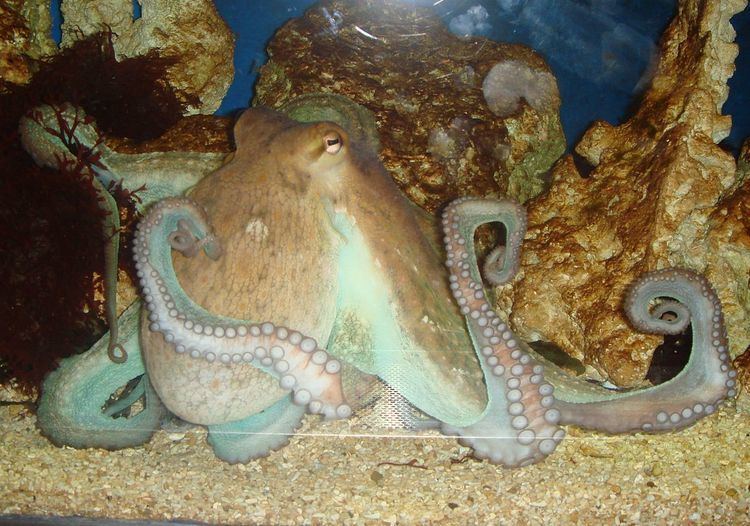 | ||
Cephalopod intelligence has an important comparative aspect in the understanding of intelligence because it relies on a nervous system fundamentally different from that of vertebrates. The cephalopod class of molluscs, particularly the Coleoidea subclass (cuttlefish, squid, and octopuses), are thought to be the most intelligent invertebrates and an important example of advanced cognitive evolution in animals.
Contents
- Predation techniques
- Dexterity
- Communication
- Tool use
- Learning
- Brain to body ratio
- Protective legislation
- References
The scope of cephalopod intelligence is controversial, complicated by the challenges of studying these elusive and fundamentally different creatures. In spite of this, the existence of impressive spatial learning capacity, navigational abilities, and predatory techniques in cephalopods is widely acknowledged.
Predation techniques
Unlike most other molluscs, all cephalopods are active predators (with the possible exception of the bigfin squid and vampire squid). Their requirement to locate and capture their prey has been a probable driving force behind the development of their intelligence, uniquely advanced among molluscs.
The Humboldt squid hunts schools of fish, showing extraordinary cooperation and communication in its hunting techniques. This is the first observation of such behaviour in invertebrates.
Crabs, the staple food source of most octopus species, present significant challenges with their powerful pincers and their potential to exhaust the cephalopod's respiration system from a prolonged pursuit. In the face of these challenges, octopuses will instead seek out lobster traps and steal the bait inside. They are also known to climb aboard fishing boats and hide in the containers that hold dead or dying crabs.
Dexterity
Dexterity, an ability essential for tool use and manipulation, is also found in cephalopods. The highly sensitive suction cups and prehensile arms of octopuses, squid, and cuttlefish are as effective at holding and manipulating objects as the human hand. However, unlike vertebrates, the motor skills of octopuses do not seem to depend upon mapping their body within their brains, as the ability to organize complex movements is not thought to be linked to particular arms.
At the Sea Star Aquarium in Coburg, Germany, an octopus named Otto was known to juggle his fellow tankmates around, as well as throw rocks and smash the aquarium glass. On more than one occasion, Otto even caused short circuits by crawling out of his tank and shooting a jet of water at the overhead lamp.
Communication
Another example of cephalopod intelligence is the communication that takes place between the more social species of squid. Some cephalopods are capable of rapid changes in skin colour and pattern through nervous control of chromatophores. This ability almost certainly evolved primarily for camouflage, but squid use colour, patterns, and flashing to communicate with each other in various courtship rituals. Caribbean reef squid can send one message using colour patterns to a squid on their right, while they send another message to a squid on their left.
Tool use
The octopus has repeatedly been shown to exhibit flexibility in the use of tools. At least four individuals of the veined octopus (Amphioctopus marginatus) have been observed retrieving discarded coconut shells, manipulating them, transporting them some distance, and then reassembling them to use as a shelter. It is surmised that the octopuses originally used bivalves for the same purpose, before humans made coconut shells widely available on the sea floor. Most hermit crabs use discarded shells of other species for habitation and other crabs choose sea anemones to cultivate on their carapaces as camouflage; numerous insects use rocks, sand, leaves and other substrate materials as building materials, however, this behaviour lacks the complexity of the octopus's fortress behaviour, which involves picking up and carrying a tool to use later.
Learning
Classical conditioning of cephalopods has been reported. One study concluded that octopuses are capable of using observational learning; however, this is disputed.
Brain-to-body ratio
Cuttlefish and octopus have the highest brain-to-body mass ratios of all invertebrates.
Protective legislation
Due to their intelligence, cephalopods are commonly protected by animal testing regulations that do not usually apply to invertebrates.
In the UK from 1993 to 2012, the common octopus (Octopus vulgaris) was the only invertebrate protected under the Animals (Scientific Procedures) Act 1986.
Cephalopods are the only invertebrates protected under the 2010 European Union directive "on the protection of animals used for scientific purposes".
